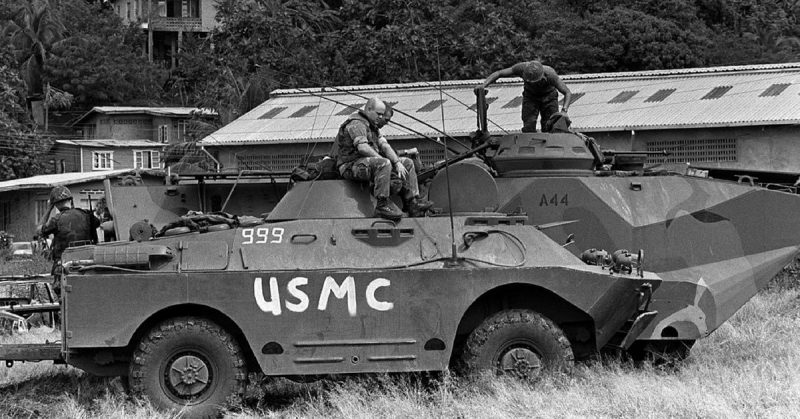Arriving in 1957
The first BRDM vehicle, the BRDM-1, entered service in the Soviet army in 1957. It had been accepted for use by the military that year and was quickly put into production.
Scouting Specialists
The BRDM vehicles were specialist armored fighting vehicles designed for reconnaissance work.
Specialist vehicles were not the only ones used for reconnaissance by the USSR and its Warsaw Pact allies. Infantry combat vehicles and battle tanks often did the same sort of work, depending on the circumstances and what was available. As with any military function, having specialist equipment designed for the purpose helped with ensuring that reconnaissance was done well.
The BRDM vehicles were perfect for that role.
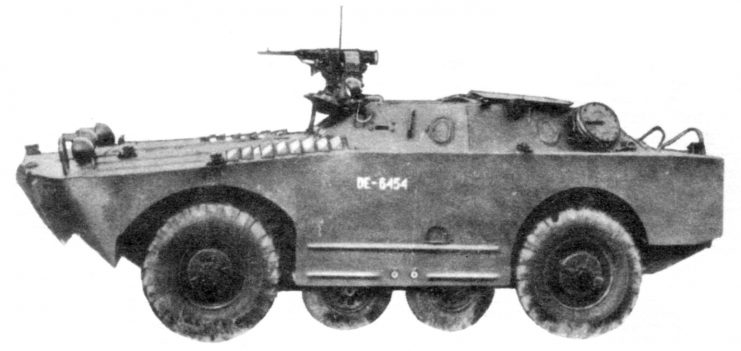
The First Cold War Recon Vehicle
The BRDM-1 was the first reconnaissance vehicle to enter Soviet service during the Cold War.
A Temporary Open Top
The BRDM-1 was originally an open-roofed vehicle, making it lighter but leaving the crew exposed. In 1958, an enclosed roof was added to provide the occupants with shelter from their enemies and adverse weather.
Original Crew
The BRDM-1 had a five-man crew. There was a commander, a driver and three other soldiers accompanying them.
Seating Arrangements
The BRDM-1 was a left-hand side drive vehicle. The commander took the other front seat. The remaining crew fitted into a compartment behind them.
Four Wheel Drive and Then Some
The BRDM-1 had two sets of four wheels.
The four larger wheels provided four-wheel drive, for better traction, acceleration, and handling. It was important in a vehicle that was often expected to work off-road and in difficult conditions. It needed to be able to move quickly over broken terrain gathering information.
The four smaller wheels sat between the main axles. They were held off the ground and lowered for use. While deployed, they improved the vehicle’s performance in crossing ditches and moving about off-road.
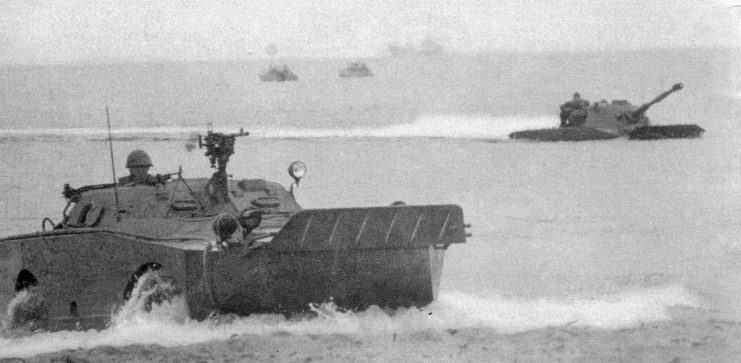
Amphibious
The BRDM-1 and BRDM-2 were amphibious vehicles. A single jet of water was used to propel them through rivers and lakes.
Dealing With Contaminants
Systems built into the BRDM-1 could detect radiation from nuclear weapons and the agents used in chemical weapons. While it could gather information on the presence of those threats, it could not protect the crew from them, as it lacked nuclear, biological, and chemical protection.
Armament on the BRDM-1
The standard weapon on the BRDM-1 was a 7.62mm SGMB machine-gun, which was mounted on the front of the roof. The vehicle carried 1,250 rounds for it. Two firing ports at the rear and two on each side allowed the crew to fire small arms out of the vehicle.
The guns fitted to the BRDM-1 were sometimes changed. The standard gun could be moved to the rear, and a heavier 12.7mm DShKM machine-gun mounted in its place at the front.
The BRDM-RKhb
One variation on the BRDM-1 was the BRDM-1-RKhb. It was a reconnaissance vehicle specifically designed for dealing with threats from non-conventional weapons. It had nuclear, biological, and chemical protection for its crew. The sensors on the standard BRDM-1 were improved to allow it to detect nuclear and chemical threats deployed in the area. Alarm systems were also fitted, including marker poles with pennants, which could be used to raise the alarm and tell nearby troops about a chemical or nuclear hazard.
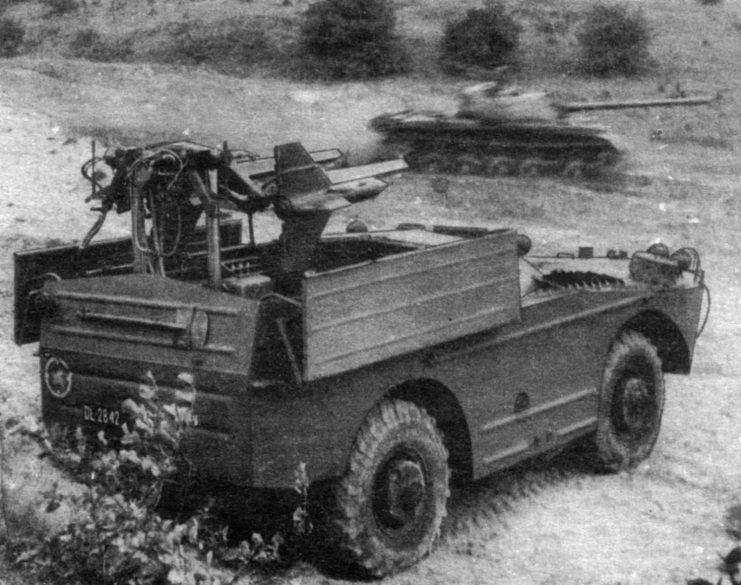
Speed
The BRDM-1 had a maximum speed on 80 kilometers per hour on-road.
Crossing Obstacles
The BRDM-1 could cross a trench up to 1.22 meters wide and a vertical obstacle up to 0.4 meters high.
BRDM-2
Introduced in the 1960s, the BRDM-2 was an improved reconnaissance vehicle based on the BRDM-1.
Adding a Turret
Unlike the BRDM-1, the BRDM-2 had a turret. It was manually operated and could hold a single man.
Improved Engine
The engine was changed on the BRDM-2. It was more powerful and was mounted at the rear of the vehicle, where previously it had been at the front.
Welded Steel
All of the BRDM models had welded steel armor. It gave them tough protection against light enemy fire.
Weaponry on the BRDM-2
The armament on the BRDM-2 was fitted in the turret. It consisted of a 14.5mm KPVT machine-gun with a telescopic sight and a smaller 7.62mm PKT machine-gun. The vehicle carried 500 rounds for the KPVT and 2,000 rounds for the lighter gun.
Each side of the BRDM-2’s hull had a single firing port for the crew to use small arms against nearby enemies.
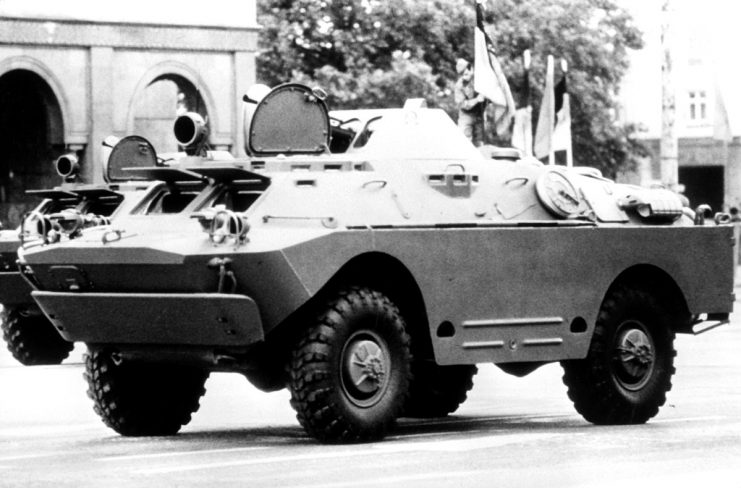
Improved Off-Road Performance
The BRDM-2 kept the two sets of four wheels that had given the BRDM-1 its strong off-road capability. They were further improved by a central system to regulate tire pressure.
NBC Protection
The BRDM-2 had nuclear, biological, and chemical protection.
Infra-Red
The BRDM-2 had infra-red driving, lights, and searchlights, enabling it to carry out its work in the dark.
The BRDM-2-RKhb
As with the BRDM-1, there was a variant on the BRDM-2 designed for nuclear, biological, and chemical hazards. The BRDM-2-RKhb had additional sensors and warning systems to alert nearby troops about any risks it discovered. Later models were more lightly armed, with a second 7.62mm PKT machine-gun replacing the 14.5mm KPVT.
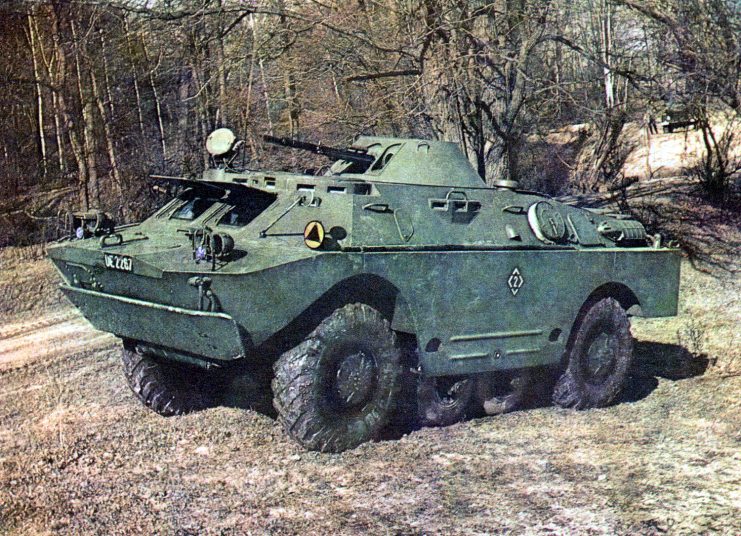
Crossing Obstacles, Mark Two
Like its predecessor, the BRDM-2 could navigate a vertical barrier up to 0.4 meters high and cross a trench up to 1.25 meters wide.
Armour
Most of the BRDM-2 was covered in 7mm armor. The nose plate had tougher 14mm armor. The belly had 2-3mm and the front of the hull 5mm, made more effective by its steep angle.
Sources:
Ian V. Hogg and John Weeks (1980), The Illustrated Encyclopedia of Military Vehicles
Russell Phillips (2017), Tanks and Combat Vehicles of the Warsaw Pact
